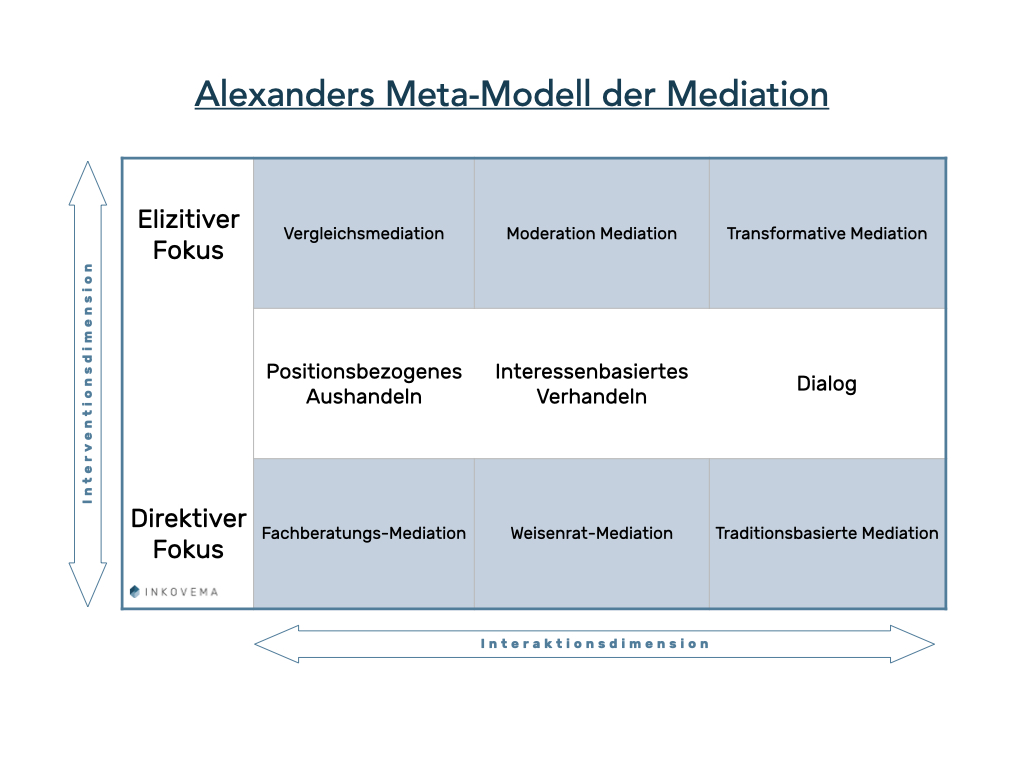Meta-model of mediation by Nadja Alexander
Maps of mediation (2 of 3)
I. Introduction
The one Mediation does not exist.
There are a variety of ways to mediate between conflicting parties in the role of a third party, to support them in their efforts to reach a settlement and to find solutions to the conflicting situation together.
Although there is a wide range of options, they are still found within Frame of reference which is based on Basic assumptions and basic patterns based.
Certain basic assumptions lead to clusters of goals, methods and interventions that can be categorised as mediation styles.
In our small Series „Maps of Mediation“ is precisely about providing such overviews and classifying models and overviews that present the order and structures of mediation methods and styles.
In the first part, we presented the map of L. Riskin (Riskin's Grid), this article is about Nadja Alexander's meta-model.
Small series of articles on the maps of mediation styles
II. Nadja Alexander's meta-model
1. introduction
Alexander's meta-model of mediation adopts a international-global perspective on mediation styles. This highlights the influence of our socialisation and cultures on the connectivity of interventions. The origin and proximity of the model from the field of intercultural mediation is unmistakable.
2. content
The meta-model provides a framework for identifying and localising mediation styles based on the work of L. Riskin. In a similar way to Riskin, Alexander develops different fields of approaches to mediating conflict within two dimensions. While Riskin's dimensions were based on the definition of the problem and the mediator's understanding of their role, Alexander develops her map based on the Dimensions of the intervention and the Interaction. This results in six fields within these two dimensionswhich Alexander also names in detail.
☞ The two dimensions can be described as follows:
- Intervention dimension: It opens up the field in which the Actions of the mediator he acts directive or elicitive. This dimension records the type of intervention by the mediator, the degree of influence exerted by the mediator and creates an attribution model, so to speak. To what extent can (or must) the outcome of the conflict parties at the end of a mediation be attributed to the mediator in terms of content, simply because his interventions have determined the content of the agreement„. The guiding perspective here is the A look at the mediatorsn.
-
- How does the mediator act?
- What interventions does she use?
- What does it do or fail to do specifically with regard to the mediators?
- Interaction dimension: This dimension takes the Communication between the conflict parties into view. How do the mediators interact? Alexander does not narrow this dimension - as Riskin does - to the question of whether the conflict parties' definition of the problem itself is narrow or broad, but leaves this dimension open in terms of content and looks at the way in which the interaction as a whole takes place. In this way, Alexander succeeds in leaving the parties' constructions of the problem and its solution to the observer or leaving those of the observer out of the equation when formulating their map. This is because how the conflict parties communicate as a whole, even if they are not (according to Western understanding) working on the „problem“, enables an appropriate localisation of even the most diverse conflict mediation efforts. Alexander ultimately divides this dimension into three different ways of communicating:
-
- Position-related negotiation (compromise-orientated),
- interest-based negotiation (consensus-orientated),
- Dialogue (communication and clarification-oriented)
☞ These two dimensions result in a total of six fields of different types and ways to mediate in conflicts. Alexander emphasises that within these fields or dimensions there is a Variety of individual mediation styles have developed – and which must also be recognised (as mediation styles!). Of course, this does not apply as an interpretation of national laws (e.g. § 1 Mediation Act), but must be assessed from the perspective of mediation. Internationally, there are a large number of conflict mediation efforts that would not be recognised as mediation in Europe, for example, or in the legal sphere of § 1 MediationsG.
3. identified fields of mediation styles
These fields identified by Alexander in her meta-model of mediation can be visualised as clusters of individual styles. They are briefly explained here at the end to demonstrate the diversity of possible styles, but also the range of the meta-model.
-
- Settlement mediation: The mediator acts as an elicitor, but ultimately works towards a compromise/comparison of the conflicting positions.
- Moderative/Facilitative Mediation: The mediator acts as an elicitor, but works towards an interest-based solution in terms of content, i.e. asks about the interests that are (or should be) behind the positions and initiates a negotiation process between these interests.
- Transformative Mediation: The mediator acts as an elicitor, but their approach is aimed at the relationship level between the conflict parties; a relationship-oriented dialogue is initiated.
- Specialist counselling mediation: The mediator acts in a directive manner, sets rules and uses the positions expressed in the dispute to reach a compromise.
- Orphans' Council Mediation: The mediator acts in a directive manner, but aims for an interest-based negotiation process between the people involved.
- Tradition-based mediation: Direct work, initiating relationship-oriented dialogue.






Leave A Comment